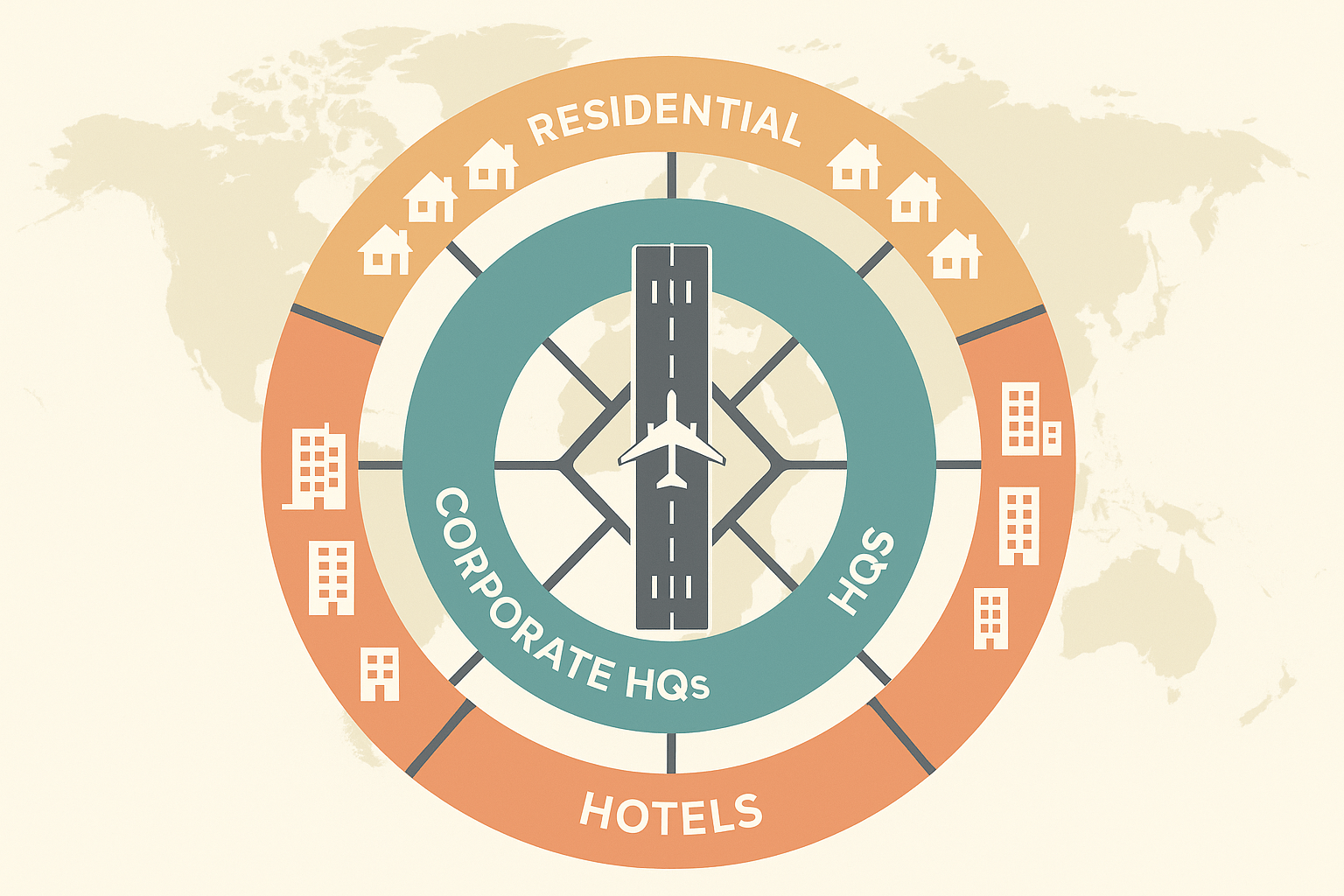The Airport as the New City Center
The term “Aerotropolis” was popularized by Dr. John D. Kasarda, a business professor and urban planning expert. His model reimagines the 21st-century city’s layout based on a simple, powerful observation: in a globalized world, air travel is the physical internet. Just as cities historically grew around seaports and then railway hubs, Kasarda argues that major airports are now the primary drivers of urban development, shaping business location, commercial development, and residential patterns.
The spatial logic of an aerotropolis is both elegant and pragmatic. It envisions a city organized in a series of concentric rings of development radiating outwards from the airport’s runways and terminals.
- The Airport Core: This is the nucleus, containing the passenger and cargo terminals, hangars, and air traffic control. It is the logistical heart, dedicated purely to aviation.
- The Aerocity (Inner Ring): Immediately surrounding the airport, you’ll find a cluster of time-sensitive, aviation-dependent businesses. This includes airport hotels, conference centers, exhibition halls, e-commerce fulfillment centers for same-day delivery, and corporate headquarters for global firms. It’s an environment built for the transient business traveler and rapid logistics.
- The Outer Rings and Corridors: Further out, development is organized along transportation corridors—highways, light rail, and dedicated “aerolanes”—that connect directly to the airport. These zones contain light manufacturing, technology parks, back-office support centers, and residential communities for the vast workforce that powers the aerotropolis.
In this model, the airport is no longer just a destination; it is an anchor tenant, a powerful economic engine whose gravitational pull reorganizes the entire urban landscape.
Human Geography: A City Shaped by Speed and Flow
The aerotropolis isn’t just a physical reconfiguration; it fundamentally alters the human geography of a region. Its economy is predicated on what experts call “the economy of speed.” Industries that rely on the rapid movement of high-value goods and people thrive here. Think of perishable goods like fresh flowers from Colombia being flown to markets in North America, time-sensitive pharmaceuticals, or high-tech components that need to be shipped just-in-time to assembly plants across the globe.
This creates a unique demographic landscape. The aerotropolis attracts a globalized, often transient, population of business executives, logistics experts, consultants, and technicians. It’s a place where you are just as likely to hear a business deal being made in Mandarin or German as in the local language. However, this model also presents significant challenges. The constant noise and environmental pollution from air traffic can create undesirable living conditions, often pushing less affluent residential areas further away and leading to social and economic stratification. The city’s economic health becomes deeply intertwined with the volatile aviation industry, making it vulnerable to global pandemics, fuel price shocks, and geopolitical tensions.
Case Study: Dubai (DXB & DWC) – The Purpose-Built Aerotropolis
Perhaps no place on Earth embodies the aerotropolis concept more fully than Dubai. Situated at a geographical crossroads between Europe, Asia, and Africa, Dubai has strategically built its entire modern economy around aviation and logistics. Its primary hub, Dubai International Airport (DXB), is one of the world’s busiest for international passengers.
But the true vision is taking shape at Dubai South, a 145-square-kilometer master-planned city with the Al Maktoum International Airport (DWC) at its heart. DWC is designed to be the world’s largest airport, a colossal hub for both passengers and cargo. The surrounding city is zoned into distinct districts for logistics, commerce, aviation, and residence. Crucially, it’s linked via a dedicated logistics corridor to the Jebel Ali Port, one of the world’s busiest seaports. This seamless sea-air-land connectivity creates an unparalleled global supply chain hub, attracting multinational corporations to its tax-free zones. In Dubai, the city didn’t just grow an airport; the airport is growing the city.
Case Study: Dallas/Fort Worth (DFW) – The Evolved Aerotropolis
If Dubai is the purpose-built aerotropolis, the Dallas/Fort Worth Metroplex in Texas is an example of an aerotropolis that has evolved more organically. Dallas/Fort Worth International Airport (DFW) is larger in land area than the island of Manhattan. Its central location within the United States makes it a perfect hub for connecting domestic and international flights.
The airport’s immense gravity has reshaped the region’s geography. Historically, the area between Dallas and Fort Worth was largely undeveloped. Today, it’s a booming economic corridor. The city of Grapevine, which lies mostly within the airport’s boundaries, serves as the de facto “aerocity”, with a dense concentration of hotels and conference centers. The nearby Las Colinas urban center in Irving is a prime example of an “edge city” that owes its existence to the airport, housing the headquarters of numerous Fortune 500 companies. Major corporate relocations, like Toyota’s North American headquarters to nearby Plano, frequently cite DFW’s global connectivity as a key deciding factor. The airport has become the region’s true economic core, pulling development and investment away from the traditional downtowns.
The Future Takes Flight
The aerotropolis is more than just an urban planning theory; it’s a geographical phenomenon actively unfolding across the globe. From Amsterdam’s Schiphol to South Korea’s Incheon, cities are leveraging their airports as instruments of economic development and urban design.
As our world becomes ever more connected, the logic of the aerotropolis becomes more compelling. It represents a city optimized for global flows of people, goods, and capital. While we must address its environmental and social challenges, we cannot ignore its influence. The next time you’re at an airport, look beyond the gates. You might just be standing in the city center of tomorrow.
